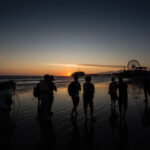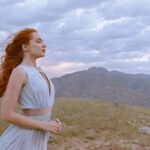William Eggleston, known for bringing color to the world of art photography, was born in Memphis, Tennessee in 1939 to a well-to-do family. He picked up his first camera when he was 18 years old and began printing his own black and white photographs. At the time, he didn’t know anything about photography. He taught himself.
In this BBC documentary, we get a glimpse of Eggleston’s life and work:
Eggleston’s peers and family describe him as rebellious and strange. He lives life how he wants to live it. And his approach to photography is the same. Rarely giving his photographs titles or identifying their locations, he calls himself a democratic photographer. He treats all subject matter equally. His unforced, one-take compositions reflect banal, everyday life.
After several years of using black and white film, Eggleston shot his first roll of color film in the mid-1960s. During that era, serious photographers shot black and white exclusively. But the way the nonconformist photographer used color caught the attention of many in the photography world. His color was underplayed. He made powerful pictures that created a sense of unease out of nothing.
He later brought the old practice of dye transfer processing, traditionally only used in the fashion and commercial industries, to the art world. He appreciated its saturation and unfading color. The technique accentuated his use of color accents.
In 1976, Eggleston’s first major show opened at the Museum of Modern Art in New York. The exhibition was the subject of harsh criticism. Reviewers called his work boring. But the photographer felt the critics just didn’t understand his work–his photos were meant to be unspectacular. Though the show was held at MoMA, they didn’t understand that his photography was modern art. Soon after, when his work became known all over the world, the critics apologized.
Now a well-known artist, with reporters and photographers clamoring for his attention, Eggleston continues photographing the seemingly mundane life around him. His life and work are a striking example of the importance of sticking to your own personal style and shooting what you like to shoot.
“Often people ask what I’m photographing. It’s a hard question to answer. And the best I’ve come up with is, I just say, ‘Life today.'”
Like This Article?
Don't Miss The Next One!
Join over 100,000 photographers of all experience levels who receive our free photography tips and articles to stay current:











I’m guessing that Saul Leiter and Fred Herzog are really tired of articles about Eggleston being the pioneer of color street photography.